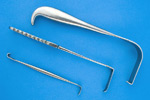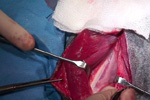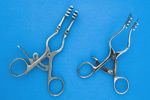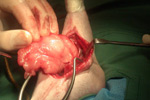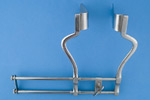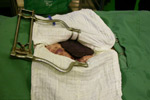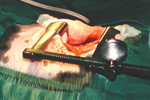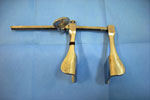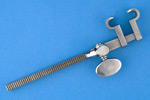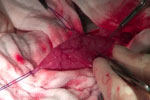Equipment Instruments
Unit 9: Basic Instruments
Topic 2c: Retractors
Retraction of tissues is vital to provision of a clear visual field. Adequate retraction is aided by selection of the correct surgical approach and making an adequate incision. Retraction can be achieved with appropriate instruments, packing or stay sutures. Minimal trauma to the retracted tissues must be a primary goal. The common practice is to protect the tissues with a moistened laparotomy sponge before the retractor is applied.
Retractors come in a wide variety of size and shapes depending on their intended use.
Retractors can be hand-held or self-retaining. The latter is indispensable if the surgeon is working without a sterile assistant. However the tendency to leave a self-retaining retractor on tissues for a prolonged period of time should be avoided. Excessive retraction pressure should not be applied, to avoid ischaemia at the point of contact.

During lengthy procedures, it is advisable to periodically release self-retaining retractors to avoid tissue trauma and ischaemia.
Hand held retractors
Self Retaining retractors
Soft tissue
Abdominal
Rib Retractors
Rib Approximators
In small breeds of dogs and cats, towel clamps may also be used to appose ribs following a thoracotomy.
Selection of Retractors and Their Uses
Balfour retractor: Any abdominal procedure via ventral midline
Gelpi or hinged Weitlaner retractor: Most orthopaedic and neurosurgical procedures
Hohmann retractor: Muscle retraction in orthopaedic surgery, inspection of menisci during stifle arthrotomy
Senn retractor: Most arthrotomies
Finochietto retractor: Thoracotomies
Stay sutures
Stay sutures are relatively atraumatic and serve to stabilise and manipulate the tissue. More than one stay suture can be use. This minimises the number of instruments in the surgical field. Stay sutures can be anchored to drapes or weighted over the incision by an instrument such as a haemostat to free the surgeon. Size 2-0 monofilament suture material is least traumatic. Common examples include stabilising the stomach or urinary bladder during exploration. Stay sutures can also be used to create a pericardial basket during cardiac procedures or to retract the dura after a durotomy to inspect the spinal cord.
Moistened sponges
Moistened sponges are particularly useful for packing off structures that creep into the surgical field. Common examples include packing of intestinal loops or lung lobes. Sometimes moistened sponges are packed behind the target organ to displace it towards the surgical field. An example of this is packing moistened sponges between the diaphragm and the liver for better exposure of a liver lobe. Remember to remove the sponges at the end of the procedure.
